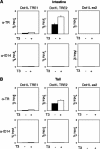Histone H3K79 methyltransferase Dot1L is directly activated by thyroid hormone receptor during Xenopus metamorphosis
- PMID: 22800560
- PMCID: PMC3414807
- DOI: 10.1186/2045-3701-2-25
Histone H3K79 methyltransferase Dot1L is directly activated by thyroid hormone receptor during Xenopus metamorphosis
Abstract
Background: Thyroid hormone (T3) is important for adult organ function and vertebrate development. Amphibian metamorphosis is totally dependent on T3 and offers a unique opportunity to study how T3 controls postembryonic development in vertebrates. Earlier studies have demonstrated that TR mediates the metamorphic effects of T3 in Xenopus laevis. Liganded TR recruits histone modifying coactivator complexes to target genes during metamorphosis. This leads to nucleosomal removal and histone modifications, including methylation of histone H3 lysine (K) 79, in the promoter regions, and the activation of T3-inducible genes.
Results: We show that Dot1L, the only histone methyltransferase capable of methylating H3K79, is directly regulated by TR via binding to a T3 response element in the promoter region during metamorphosis in Xenopus tropicalis, a highly related species of Xenopus laevis. We further show that Dot1L expression in both the intestine and tail correlates with the transformation of the organs.
Conclusions: Our findings suggest that TR activates Dot1L, which in turn participates in metamorphosis through a positive feedback to enhance H3K79 methylation and gene activation by liganded TR.
Figures






Similar articles
-
Histone methyltransferase Dot1L is a coactivator for thyroid hormone receptor during Xenopus development.FASEB J. 2017 Nov;31(11):4821-4831. doi: 10.1096/fj.201700131R. Epub 2017 Jul 24. FASEB J. 2017. PMID: 28739643 Free PMC article.
-
Direct activation of tRNA methyltransferase-like 1 (Mettl1) gene by thyroid hormone receptor implicates a role in adult intestinal stem cell development and proliferation during Xenopus tropicalis metamorphosis.Cell Biosci. 2020 May 4;10:60. doi: 10.1186/s13578-020-00423-1. eCollection 2020. Cell Biosci. 2020. PMID: 32391142 Free PMC article.
-
Thyroid hormone directly activates mitochondrial fission process 1 (Mtfp1) gene transcription during adult intestinal stem cell development and proliferation in Xenopus tropicalis.Gen Comp Endocrinol. 2020 Dec 1;299:113590. doi: 10.1016/j.ygcen.2020.113590. Epub 2020 Aug 20. Gen Comp Endocrinol. 2020. PMID: 32827515 Free PMC article.
-
Unliganded thyroid hormone receptor regulates metamorphic timing via the recruitment of histone deacetylase complexes.Curr Top Dev Biol. 2013;105:275-97. doi: 10.1016/B978-0-12-396968-2.00010-5. Curr Top Dev Biol. 2013. PMID: 23962846 Free PMC article. Review.
-
Life Without Thyroid Hormone Receptor.Endocrinology. 2021 Apr 1;162(4):bqab028. doi: 10.1210/endocr/bqab028. Endocrinology. 2021. PMID: 33558878 Free PMC article. Review.
Cited by
-
The emerging roles of DOT1L in leukemia and normal development.Leukemia. 2014 Nov;28(11):2131-8. doi: 10.1038/leu.2014.169. Epub 2014 May 23. Leukemia. 2014. PMID: 24854991 Review.
-
Cytological and morphological analyses reveal distinct features of intestinal development during Xenopus tropicalis metamorphosis.PLoS One. 2012;7(10):e47407. doi: 10.1371/journal.pone.0047407. Epub 2012 Oct 10. PLoS One. 2012. PMID: 23071801 Free PMC article.
-
Thyroid hormone receptor actions on transcription in amphibia: The roles of histone modification and chromatin disruption.Cell Biosci. 2012 Dec 20;2(1):42. doi: 10.1186/2045-3701-2-42. Cell Biosci. 2012. PMID: 23256597 Free PMC article.
-
Connecting the DOTs on Cell Identity.Front Cell Dev Biol. 2022 Jun 6;10:906713. doi: 10.3389/fcell.2022.906713. eCollection 2022. Front Cell Dev Biol. 2022. PMID: 35733849 Free PMC article. Review.
-
Hypoxia induces DOT1L in articular cartilage to protect against osteoarthritis.JCI Insight. 2021 Dec 22;6(24):e150451. doi: 10.1172/jci.insight.150451. JCI Insight. 2021. PMID: 34727094 Free PMC article.
References
-
- Yen PM. Physiological and molecular basis of thyroid hormone action. Physiol Rev. 2001;81:1097–1142. - PubMed
-
- Hetzel BS. The story of iodine deficiency: An international challenge in nutrition. Oxford University Press, Oxford; 1989.
-
- Gilbert LI, Tata JR, Atkinson BG. Metamorphosis: Post-embryonic reprogramming of gene expression in amphibian and insect cells. Academic, New York; 1996.
-
- Shi Y-B. Amphibian Metamorphosis: From morphology to molecular biology. Wiley, New York; 1999.
LinkOut - more resources
Full Text Sources

